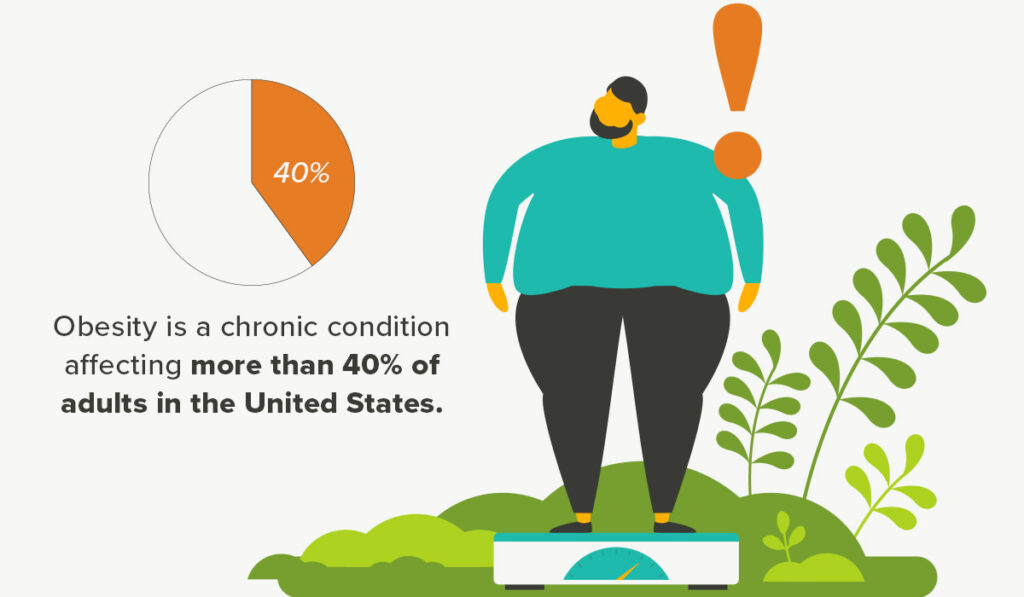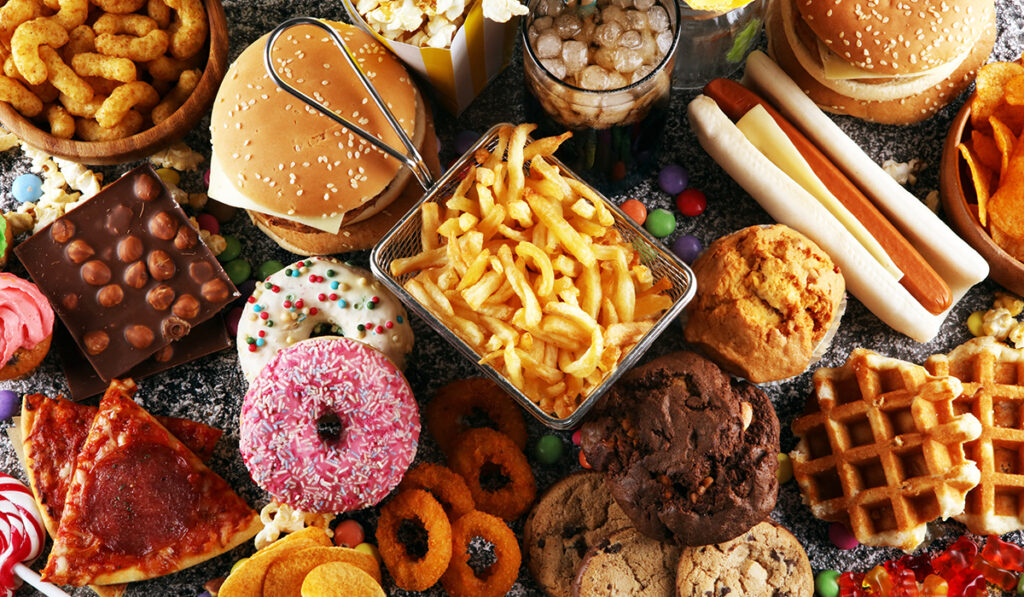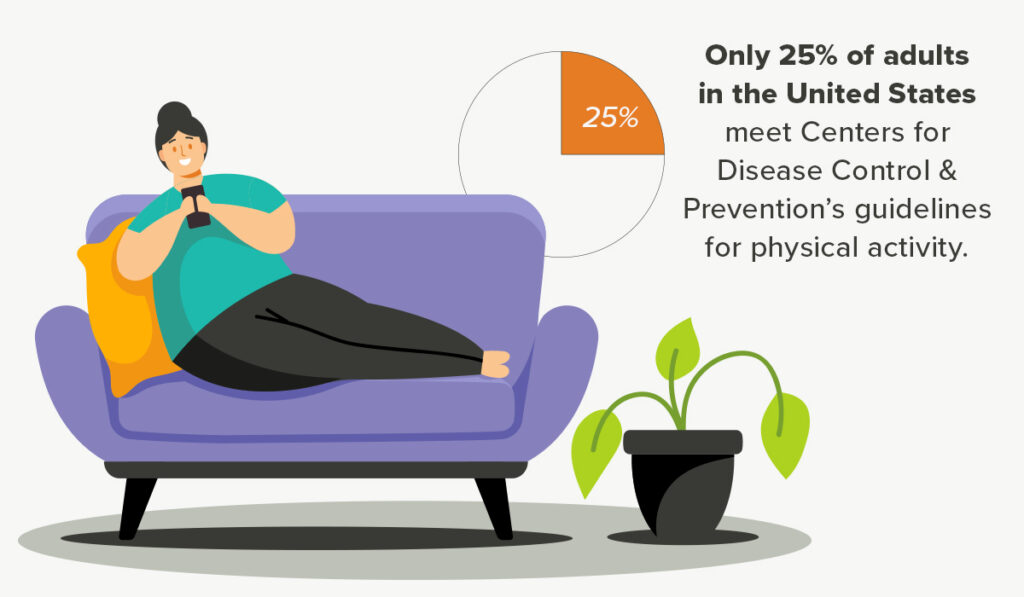Obesity is a chronic condition affecting more than 40% of adults in the United States. Worldwide, it affects 16%. By country, the United States ranks in the top 10 of those with the highest obesity rates.
Obesity is a complex topic, and researchers are still trying to understand what causes it and why the United States has such high rates. However, many functional medical practitioners agree that the three main causes of obesity are food quality, stress, and lack of movement.

All these factors can contribute to worsened metabolic health. Only 12% of adults in the United States are considered metabolically healthy, meaning they have optimal numbers of five metrics, including waist circumference.
Again, lots of factors play a role in the development of obesity. At first glance, the factors of poor food quality, stress, and lack of movement may appear to be solely lifestyle related. And they are lifestyle factors to a certain extent. But at the same time, societal, governmental, and other factors also drive these lifestyle factors.
Here, we explore how poor food quality, stress, and lack of movement contribute to obesity. Plus, we’ve got tips on what you can do to lower your risk for obesity, manage weight, and take charge of your health, even when some societal factors are working against you.
How Poor Food Quality Contributes To Obesity
The United States has the highest intake in the world of ultra-processed foods (UPFs). When looking at the total calorie intake in the United States and Canada, 80% of calories come from UFPs, which have multiple associations with obesity.
UPFs are often full of added sugars, like high-fructose corn syrup, and additives for color or preservation. They’re also often full of empty calories, those that offer little nutritional value.

Yet these foods continue to remain cheaper in the food supply when compared to whole foods. Plus, the United States government subsidizes UPFs. For example, the government subsidizes corn production, which contributes to the use of cheap and harmful high-fructose corn syrup in food as an ingredient.
Additionally, the high carbohydrate content of UPFs tends to raise blood sugar and subsequently contribute to insulin resistance, making people more at risk for prediabetes and Type 2 diabetes. Insulin resistance and obesity are linked, with each contributing to the other in a vicious cycle.
Furthermore, UPFs contribute to mitochondrial dysfunction. Mitochondria are the powerhouses of cells. They turn the foods we eat into energy. When this process is impaired, weight gain or obesity can result.
UPFs can also disrupt the ways your body signals to your brain that you’re full, leading to overeating. And these products negatively affect your gut microbiome. A disrupted microbiome can contribute to weight gain.
Basic Tips:

Eliminate ultra-processed foods as much as possible.
Add more whole foods to your diet. This will naturally reduce your intake of ultra-processed foods.
Reduce or eliminate intake of added sugars, especially high-fructose corn syrup.
How Stress Contributes To Obesity
The United States is among the top 15 countries in the world with the highest levels of stress. This could be for several reasons. One is that the United States doesn’t require by federal law paid time off and it trails behind many other countries in vacation time. Many other factors also play a role. The bottom line is that people in the United States are stressed.

Our stress response can be good thing when we’re faced with a sudden danger and need to act fast. However, our day-to-day stress is usually about work deadlines, family responsibilities, money issues, and more. A treadmill of regular stress leads to chronic stress, which can harm health.
Stress activates our fight-or-flight response, releasing stress hormones. This floods your bloodstream with stored glucose to give you energy to act in an emergency. But with a few exceptions, we typically don’t need this surge. High blood sugar over time can contribute to insulin resistance, which is associated with obesity.
At the same time, stress hormones can contribute to visceral fat accumulation. Visceral fat is the type that surrounds your organs, and it is associated with worsened health. It contributes to insulin resistance, disrupted signals that control our appetite , and more—all of which can lead to obesity. Stress can also contribute to overeating if we reach for foods to help calm us.
Basic Tips:

Engage in mindfulness practices, such as meditation, yoga, or breathwork. These tools can help you reduce chronic stress and teach you tools to use in acute moments of stress.
Up your physical activity, which can contribute to stress reduction.
Eat more omega-3 fatty acids, which may help reduce stress by lowering inflammation and cortisol levels and helping the body recover.
How Lack Of Movement Contributes To Obesity
High-income Western countries, such as the United States, have some of the lowest levels of physical activity. Only 25% of adults in the United States meet Centers for Disease Control and Prevention’s guidelines for physical activity. Many factors contribute to lower levels of exercise, including a lack of access to exercise facilities or spaces, a lack of time, and more.

Not getting adequate exercise can contribute obesity. We all know that exercise burns calories. But weight management and fat loss are about more than how many calories you burn. Complex metabolic process are at play with obesity. However, a lack of movement can contribute.
Aerobic exercises include running, walking, swimming, biking, rowing, and more. These exercises help increase your mitochondria and their functioning. Again, mitochondria are the powerhouses of your cells and they convert the foods we eat into usable energy. Sedentary behavior, on the other hand, contributes to mitochondrial dysfunction, which contributes to obesity.
Aerobic exercise also helps manage blood sugar, helping to prevent obesity. This is because exercise allows glucose uptake into cells without the need for insulin release. This helps keep the body more insulin sensitive.
We also lose muscle mass as we age, which can contribute to fat gain. With the loss of muscle, we often gain fat. But muscle tissue is metabolically healthier than fat. Muscle soaks up glucose from your bloodstream after exercise, again without the need for insulin. And increasing your muscle mass also boosts metabolism, meaning you burn more calories at rest.
Basic Tips:

Build mini bouts of movement into your day. For example, take a quick walk at lunch, do a few squats between meetings, etc.
Aim for 150 minutes of moderate or 75 minutes of vigorous cardiovascular exercise per week.
Engage in strength training at least twice per week.
Takeaway
Many factors can contribute to obesity, but top contributors include poor diet quality, too much stress, and a lack of physical activity. We may not be able to change some factors, such as our genetics, but lifestyle factors are within our control. And making simple changes can help reduce our risk of obesity.
Knowing that societal factors also sometimes work against us can help empower us to take control of our own health and make sustainable changes that contribute to weight management in the long term.

About The Author: Jennifer Chesak, MSJ
Jennifer Chesak is an award-winning author, science and medical journalist, editor, and fact-checker, and her work has appeared in several national and international publications, including the Washington Post and BBC. Recently her debut nonfiction book on women’s health was awarded the IBPA Benjamin Franklin silver medal. Chesak earned her master of science in journalism from Northwestern University’s Medill. She currently teaches in the journalism and publishing programs at Belmont University, leads various workshops at the literary nonprofit The Porch, and serves as the managing editor for the literary magazine SHIFT. Find her work at jenniferchesak.com and follow her on socials @jenchesak.






